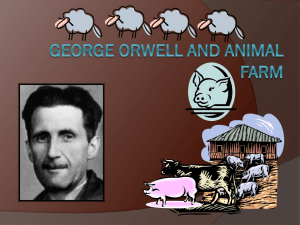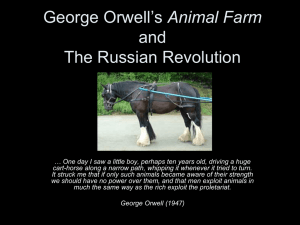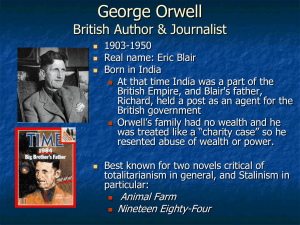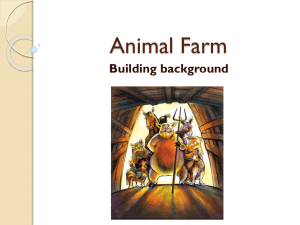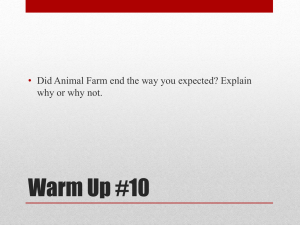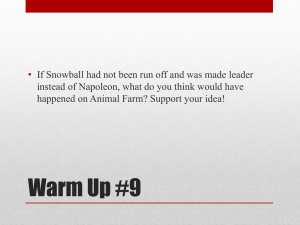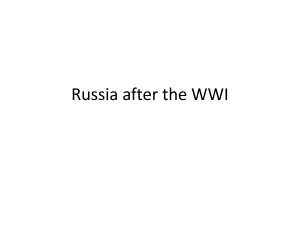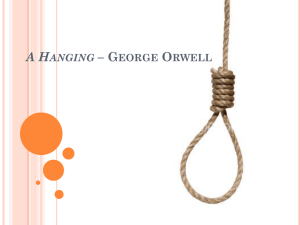Animal Farm
advertisement
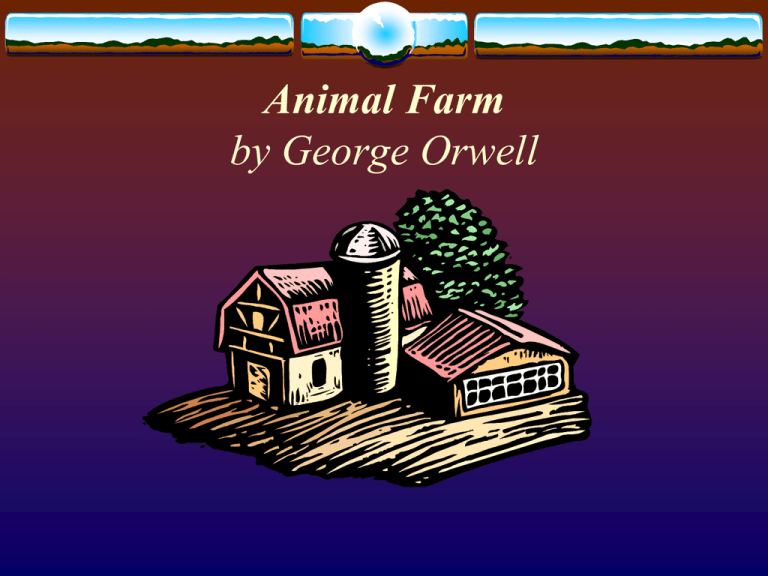
Animal Farm by George Orwell George Orwell Background on Orwell George Orwell was born in Bengal, India. His real name is Eric Blair. In 1904, his mother moved back to England so that her children could begin their education there. Orwell received a scholarship to study at Eton in 1917. Aldous Huxley (author of Brave New World) was one of his teachers. Background on Orwell At Eton, Orwell was first exposed to popular liberal and socialist ideas. After graduating in 1921, he joined the Civil Service and went to Burma as a sergeant in the Indian Imperial Police. He quit this job in 1927 because he did not like being an instrument of power over the Burmese people. Background on Orwell After quitting the Civil Service, Orwell chose to live among the working-class people of Paris and the homeless in England. This experience lasted for more than a year. He wrote about these experiences in his first book, Down and Out in Paris and London (published in 1933). At this time, he adopted his pseudonym George Orwell. Background on Orwell He took Orwell from an English river near where he once lived, and he chose George as his first name because it was typically English. At this time, he worked as a teacher, and after he married, he and his wife ran a village pub and the general store. In 1936, he became a socialist, and his publisher encouraged him to write about oppressed people. He did. Background on Orwell In 1945, he published Animal Farm, one of the two novels for which Orwell is most famous. 1984 , Orwell’s most celebrated novel, was published in 1949. Orwell got the idea for Animal Farm from seeing a small boy driving a horse and whipping it whenever it tried to turn. Background on Orwell “It struck me,” said Orwell, “that if only such animals became aware of their strength, we should have no power over them, and that men exploit animals in much the same way as the rich exploit the proletariat (working class).” Orwell disapproved of Britain’s privileged class and believed instead in the traditions and virtues of the working class. Background on Orwell These beliefs were fostered by a visit Orwell had made to Spain about ten years earlier. He went to Spain to write about their Civil War, and even to fight in it. He was wounded in his neck in battle by a sniper’s bullet which caused his voice to become permanently altered. The war experience had given him a horrifying glimpse of political reality. Background on Orwell He saw how revolutionary causes could become corrupt and evolve into totalitarianism (a kind of dictatorship where one political party has total control and all opposition is ruthlessly suppressed), which he saw as the future’s threat to human freedom. Later in Russia, Orwell saw a powerful dictator-Joseph Stalin-come up through the revolutionary ranks and eventually oppress the people as badly as the Czar had done before him. Background on Orwell To show how a whole nation could be enslaved, Orwell created his fable (a brief, often humorous, tale that presents a moral or message) about the animals on Manor Farm. Orwell said that the book was the first “in which I tried, with full consciousness of what I was doing, to fuse political purpose and artistic purpose in one whole.” Historical Context and background information on Animal Farm The novel is based upon the events that occurred during and after The Russian Revolution of 1917. Various historical figures are represented by different animals and events. The ruling family at the time of the Revolution was the Romanovs. The Czar was Nicholas II and his Czarina (wife) was Alexandra. Nicholas and Alexandra had one of the most passionate love affairs of their day. Nicholas and Alexandra Historical Context and background information on Animal Farm Nicholas and Alexandra had five children together: 4 daughters-Olga, Tatiana, Maria, and Anastasia. They also had one son- Alexei. Unbeknownst to the majority of the Russian public, Alexei was a hemophiliac. Nicholas had no desire to be Czar of Russia, but he was suddenly thrown into power at the young age of 28 when his father died. The Russian Imperial Family daughters Alexandra and Alexei The Russian Imperial Family The Russian Imperial Family Historical context and background information on Animal Farm Nicholas was the absolute sovereign of Russia, which meant that he controlled every aspect of the government. The downfall of the Romanov Dynasty began with an incident that later became known as “Bloody Sunday.” By the early 1900’s, the writings of Karl Marx, increasing hardship, and the injustices of the czars inspired widespread revolt among the working class. Karl Marx Historical context and background information on Animal Farm Communism is an economic system where the basic idea is that everybody does jobs in which they excel, and everybody gets everything that they need. Karl Marx is considered the “Father of Modern Communism.” His beliefs were known as Marxism. Marxism is a theory of class struggle. Historical context and background information on Animal Farm Marx divided people into two main classes: Bourgeoisie: class of modern capitalists. They are the minority of people who own the means of production. Proletariat: the modern working class who always lived at the lowest possible level to sustain health while providing wealth for the upper class. Karl Marx arranged his theories into a book entitled The Communist Manifest. Historical context and background information on Animal Farm Marx believed that through revolution private property would cease to exist and that workers would break free from their metaphorical chains. The problem with this theory is that once the upper class dissolved then the lower class would rise and take its place, and the cycle would start anew. Without competition there would be no market; thus, modern industry would cease to exist. Historical context and background information on Animal Farm 1904 was a bad year for Russian workers. Prices of essential goods rose so quickly that real wages declined by twenty percent. When four workers were dismissed at the Putilov Iron Works, a priest named George Gapon called for industrial action. Over the next few days more than110,000 workers in St. Petersburg went on strike. Historical context and background information on Animal Farm In an attempt to settle the dispute, Gapon decided to make a personal appeal to Czar Nicholas. He drew up a petition outlining the worker’s sufferings and demands. This list included calling for a reduction in the working day to eight hours, increasing wages, and improving working conditions. Numerous aspects of the petition were based upon Karl Marx’s ideas. Over 150,000 people signed the petition. Historical context and background information on Animal Farm On January 22, 1905, Gapon led a large procession of workers to the Winter Palace in order to present the petition to Nicholas. When the procession of workers reached the palace, they discovered that Nicholas had received word about their visit and decided to leave. The guards that were surrounding the palace did not know how to handle the angry mob; instead of trying to reason with them, the guards decided to open fire. Historical context and background information on Animal Farm Over 100 workers were killed and over 300 were wounded in the incident. After this incident, the people began to view Nicholas as a blood-thirsty tyrant. There were numerous revolts that sprang up around Russia seeking retribution for the fallen workers. This incident laid the groundwork for the Russian Revolution. Historical context and background information on Animal Farm WWI soon broke out and Russia found itself involved in the war. Nicholas decided that he wanted to be a part of the action, so he made it a point to go out with the Russian troops and provide help. His wife and daughters decided that they wanted to help as well, so they became nurses. During this time Nicholas makes some egregious decisions concerning the war effort. The Russian people begin to blame his wife, who was part German, and her so- called priest Rasputin for influencing the Czar’s Historical context and background information on Animal Farm Nicholas soon gets word of a planned revolt in St. Petersburg, so he leaves the front in an attempt to quell the revolt. On his way to the city, the Bolshevik Party set up a barricade so that the train could not get through. The train is forced to take an alternate route, which unfortunately leads the train right into Bolshevik territory. Nicholas is taken prisoner and is forced to abdicate his throne. Historical context and background information on Animal Farm On March 15, 1917, Czar Nicholas II was overthrown and later executed, along with his wife and five children. A provisional government was set up to take over Russia. Seven months later, the Bolsheviks (the majority), led by Vladimir Lenin, overthrew the provisional government. This coup was known as the October Revolution. Vladimir Lenin Historical context and background information on Animal Farm Even though Lenin was a follower of Marxism, he did not agree with every aspect of Karl Marx’s philosophy. Lenin eventually comes up with his own theory known as Leninism. Unlike Marx, Lenin believed that once the proletariat became the only class, then the State’s role should not disappear entirely, but instead should be led by a Vanguard Party. Historical context and background information on Animal Farm Lenin believed that this party needed to exist for quite some time to ensure protection of the ‘socialist state’ from its internal and external enemies. Lenin’s policies were often more violent and sneaky than those of Marxist beliefs. Lenin believed in the total liquidation of the bourgeoisie class, as well as anyone who stood in the way of his Marxist dreams. Historical context and background information on Animal Farm After the Russian Revolution of 1917, the first official socialist state was created with Lenin at the helm. The Bolsheviks changed their name to the Russian Communist Party after the Revolution. They later became known as “The Reds.” Lenin became so well-loved and revered that upon his death his body was placed on display for all to see and admire. After his death in 1924, a power struggle emerged for control of the Communist Party. Historical context and background information on Animal Farm The death of Lenin and the dissolution of MarxistLeninist thought engendered two new Russian leaders: Leon Trotsky and Joseph Stalin. A power struggle soon emerged between Trotsky and Stalin with different factions arising from their conflicts of ideology. Trotsky was a strict Marxist and talented party organizer who had played an important role in the Russian Revolution. Leon Trotsky Historical context and background information on Animal Farm Trotsky believed that the only way a society could survive was through permanent revolution. He reinforced the need for a worldwide socialist class. This idea was later known as Trotskyism. Stalin (secretary general of the Communist party) favored a modified form of Marxism. He argued that a socialist state could and must first be created within Russia and that Russia would be the leader for the international proletariat. Joseph Stalin Historical context and background information on Animal Farm Later, however, Stalin’s ideas and practices quickly turned totalitarian. The power-hungry Stalin would not let anything stand in his way. Totalitarianism is a form of government with a strong central rule that attempts to control individuals by means of coercion and repression. Stalin eventually won the power struggle and had Trotsky exiled to Mexico where he is later killed by USSR agents. Historical context and background information on Animal Farm Stalin began several 5-year plans to stimulate the Russian economy, which actually decreased under his collective farming. Although he took the formal title of Premier in 1941, Stalin was an absolute dictator. Any opposition to Stalin was subject to secret arrests, fake trials, forced labor camps, and mass executions. Historical context and background information on Animal Farm Estimates put the death rate in the neighborhood of 1020,000,000. Stalin guided Russia through WWII as an ally of the United States. This friendship perhaps explains why numerous details about Stalin’s regime were not made public. He took Russia from an agricultural to an industrial society. His death in 1953 brought about a series of other Premiers who continued with the same oppression of the people, although some changes slowly ensued. Historical context and background information on Animal Farm Animal Farm, which was published the year after World War II ended, is an anti-utopian novel which shows man at the mercy of a force he can not control. Orwell wanted people to remember the errors of the past and learn from history’s mistakes. Animal Farm is an allegory. Historical context and background information on Animal Farm An allegory is a story that can be read on two distinct levels. Characters and events in an allegory represent something else, and they are used by the writer to convey a moral or philosophical message. Animal Farm is also a satire. A satire uses ridicule to make certain people, events, or institutions appear foolish. One of the elements of satire is irony. Orwell uses situational, verbal, and dramatic irony in Animal Farm. Historical context and background information on Animal Farm Another aspect that plays a vital role in Animal Farm is the use of propaganda. Propaganda is any widespread promotion of particular ideas, doctrines, etc. The following slides present different forms of propaganda and how they are used. Propaganda Calling – giving an idea a bad label – is used to make us reject and condemn the idea without examining the evidence. Glittering Generality – associating something with a “virtue word” (ex. freedom, democracy, motherhood, health, etc.) – is used to make us accept and approve the thing without examining the evidence. Name Propaganda – either carries the authority and prestige of something respected and revered over to something else in order to make the latter acceptable, or carries authority and disapproval to cause us to reject and disapprove something. Transfer Propaganda – consists of having some respected or hated person say that something or someone is good or bad. Plain Folks –the method by which a speaker attempts to convince his audience that he and his ideas are good because they are “of the people,” the “plain folks.” Testimonial Propaganda Stacking – involves the selection and use of information in order to give the best or the worst possible case for an idea, program, person, or product. Card Band Wagon – has as its theme, “everybody – at least all of us – is doing it”; the propagandist attempts to convince us that all members of a group to which we belong are accepting his program and that we must therefore follow our crowd and “jump on the band wagon.” Propaganda –uses compliments to compel the audience to agree with the propagandist. Flattery Ex. You’re so smart, I’m sure you’ll realize that this product is the best one for you! Propaganda & Snob Appeal –the audience believes that they are part of the elite if they agree with the propagandist. Prestige Ex. “Anyone who is anyone…” or “The best of the best…” Propaganda Jargon – The propagandist uses confusing (and sometimes false) terminology to convince the audience that he is believable. Pseudoscientific Ex. The USDA has released a report stating that the amino acids found in lactic excretions in bovine mammals have corroded the cardiac artery of many consumers leading to massive lumbar failure.
